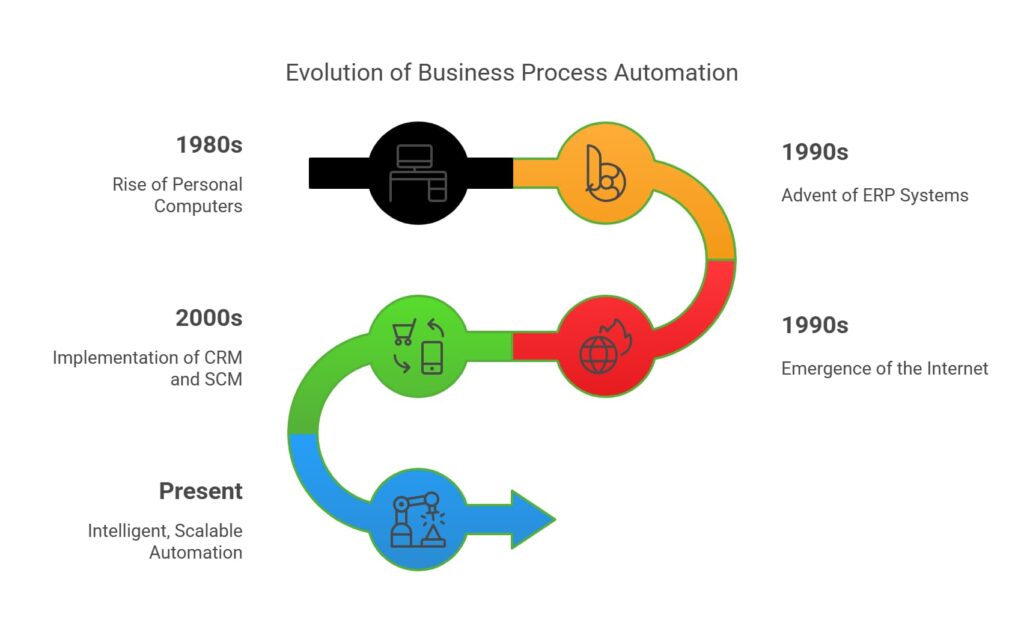

Close

Business Process Automation (BPA) has fundamentally transformed how organizations function—evolving from human-driven tasks to intelligent systems that operate with minimal oversight. This shift didn’t happen overnight. It unfolded over decades, shaped by technological advancements, operational complexities, and the relentless drive for efficiency.
Today, BPA isn’t just a helpful tool—it’s a strategic necessity for staying competitive in a digital-first world.
Let’s explore how we got here—and what lies ahead in the journey from manual to autonomous automation.
The Early Days: Manual Processes
Before the age of technology, businesses were almost entirely dependent on human labour. Tasks like bookkeeping, data entry, and inventory management were done manually, often using paper files and physical registers. These processes were slow, prone to error, and difficult to scale.
The Industrial Revolution was the first actual step towards automation. Factory floors saw the introduction of machinery run by steam, which started taking over manual labour. Even though these machines greatly improved productivity, they needed constant human intervention. It was the initial vision of how tools could aid man in making efficiency a better thing.
The Digital Spark: Early Computing (1950s–1970s)
The introduction of mainframe computers in the 1950s made new opportunities available for conducting business. Those giant machines, while bulky and expensive, could crunch huge quantities of data many times faster than humans. They were applied chiefly to repetitive data-processing functions such as payroll, billing, and inventory management.
While narrow in scope, early computing provided the digital groundwork for what would eventually be modern-day business process automation. For the first time, businesses were able to move some of their core activities from manual to machine-based systems.
The Software Boom: 1980s–1990s
During the 1980s, the mass popularity of personal computers transformed the workplace. Software applications enabled businesses of all sizes to automate mundane tasks such as word processing, financial reporting, and communication.
The advent of Enterprise Resource Planning (ERP) systems in this period was a milestone. ERP systems integrated various departments—finance, human resources, procurement—into a single system. By doing so, the duplication was eliminated, and there was improved accuracy of data, which facilitated more strategic decision-making.
The Internet Era: 1990s–2000s
The emergence of the internet introduced a new generation of business automation. Real-time communication, cloud storage, and web-based applications facilitated businesses to scale at a global level. Customer support, procurement, and supply chain coordination became more digitized.
This era witnessed the mass implementation of systems such as Customer Relationship Management (CRM) and Supply Chain Management (SCM), which facilitated customer interaction and logistics automation. Businesses could now engage global markets 24/7, with information flowing freely across borders.
The Present: Intelligent, Scalable Automation
Today’s business process automation is highly intelligent, scalable, and user-friendly. It’s no longer just about cutting down on manual work—it’s about building smarter workflows that self-optimize over time.
Robotic Process Automation (RPA) uses software bots to carry out repetitive tasks such as invoice processing or report generation. These bots work non-stop, following precise rules with zero error.
Artificial Intelligence (AI) and Machine Learning (ML) take automation to the next level by reviewing data, identifying trends, and making choices. From AI-based chatbots resolving customer questions to AI-driven fraud detection systems in banking, these technologies are transforming the manner in which work is accomplished.
Low-code/no-code platforms are making automation accessible to everyone. With drag-and-drop visual builders, even non-technical people can automate processes. Cloud computing makes these solutions readily available and always updated.
And with big data and analytics, companies are now able to make data-driven decisions with intelligent insights.

Impact in the Real World
In a 2022 McKinsey survey, as much as almost 25% of the business capital expenditure within the next five years will be invested in automation technologies. Sectors such as retail, food & beverage, and automotive are at the forefront.
Automation eliminates process bottlenecks and increases productivity. Workers can now redirect attention away from routine activities to innovation, problem-solving, and customer engagement. The payoff? Increased delivery speed, improved accuracy, and enhanced overall performance.
The Four Phases of BPA Success
Implementing business process automation effectively requires a structured approach. Here are the four essential phases:
1. Analysis
Start by identifying inefficiencies. Map out current workflows, measure delays or redundancies, and pinpoint which processes are ripe for automation. This ensures you choose tools that align with your business goals.
2. Implementation
Select the right BPA technologies and tailor them to your organization. Train your teams, define clear roles, and run pilot programs. Testing early ensures smoother large-scale deployment.
3. Integration
Ensure that your new automation tools connect seamlessly with existing systems—such as ERP, CRM, and HR software. APIs and integration platforms can help unify your data and eliminate silos.
4. Maintenance & Support
Automation isn’t “set it and forget it.” Systems must be monitored and regularly updated. Process intelligence tools can help identify emerging inefficiencies and suggest continuous improvements.
The Future: Toward Full Autonomy
The next chapter in BPA is autonomous automation—systems that learn, adapt, and act independently based on changing inputs.

Key Trends Leading the Way:
Automation Across Industries
Automation is transforming nearly every sector:
Manufacturing
Smart factories use IoT sensors and AI for real-time production monitoring, predictive maintenance, and efficiency optimization.
Healthcare
Hospitals use automation to streamline patient scheduling, assist in diagnoses, and manage electronic health records securely.
Finance
Banks and financial firms automate everything from regulatory compliance to fraud detection and risk assessment using AI and analytics.
Retail & eCommerce
AI chatbots, inventory automation, and personalized product recommendations improve customer experience and operational efficiency.
The Human Side of Automation
While there are fears that automation will displace jobs, the reality is more nuanced. Automation is shifting job roles—not eliminating them. Repetitive tasks are being offloaded to machines, allowing people to focus on higher-value work.
This shift requires a focus on reskilling and upskilling. Companies must train employees to manage and collaborate with automated systems. A hybrid workforce—where humans and digital workers operate in tandem—is the future of work.
Ethical and Regulatory Considerations
Automation also raises important ethical and legal questions.
A global effort to standardize automation ethics and compliance will be essential to build public trust.
The Road Ahead
From steam engines to self-learning bots, Business Process Automation has come a long way. What began as a tool for efficiency is now a catalyst for innovation and transformation.
The future is not just automated—it’s autonomous. Businesses that embrace this change early will gain a strategic edge in agility, productivity, and resilience. Those that don’t risk falling behind in an increasingly competitive and tech-driven landscape.
As we move forward, BPA will not just support business—it will define it.
We co-create with our customers at the center, combining deep domain expertise with innovative technology and talent solutions to accelerate growth. Our passion for excellence drives us to transform businesses, unlocking new opportunities and delivering lasting impact.
Subscribe to our newsletter to get our newest articles instantly!
Smart Leaders Are Rethinking Outsourcing. Are You? As global businesses face margin pressure and tech talent gaps, outsourcing is evolving from a cost play to a growth strategy. We're inviting senior leaders to share their perspectives in a short survey that explores how companies are scaling faster and operating leaner through smarter outsourcing. Take the short survey now and lead the next wave of global delivery excellence.
